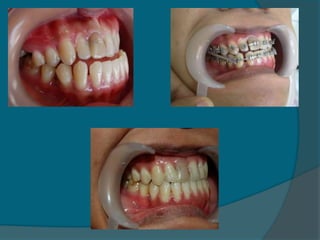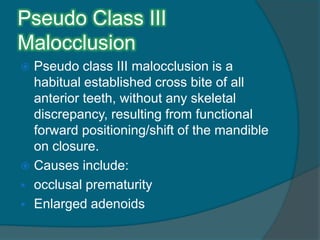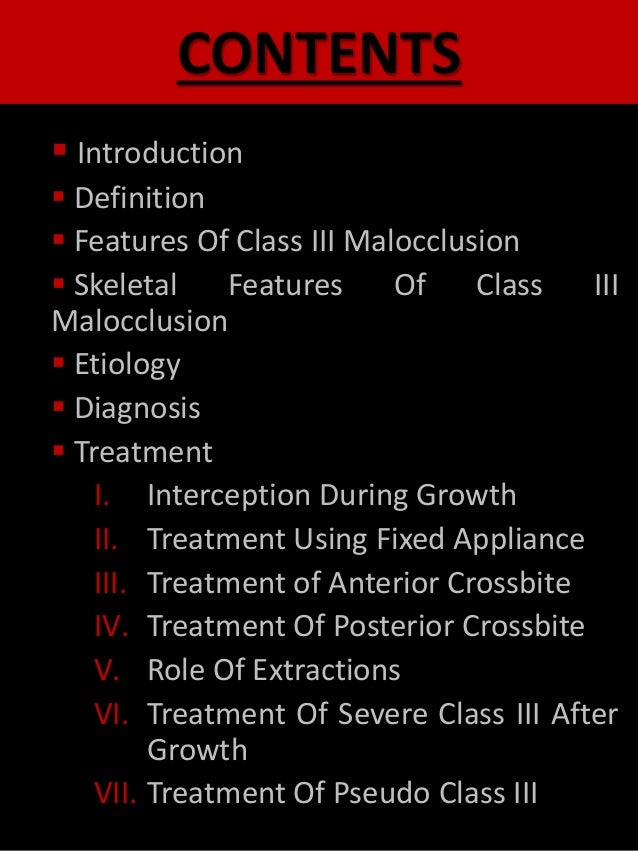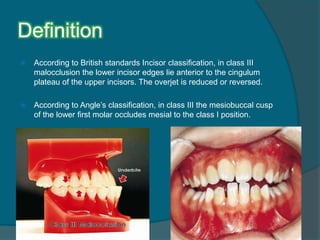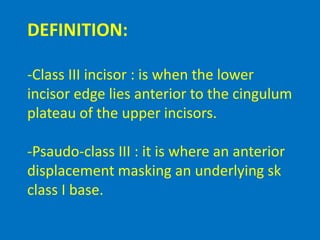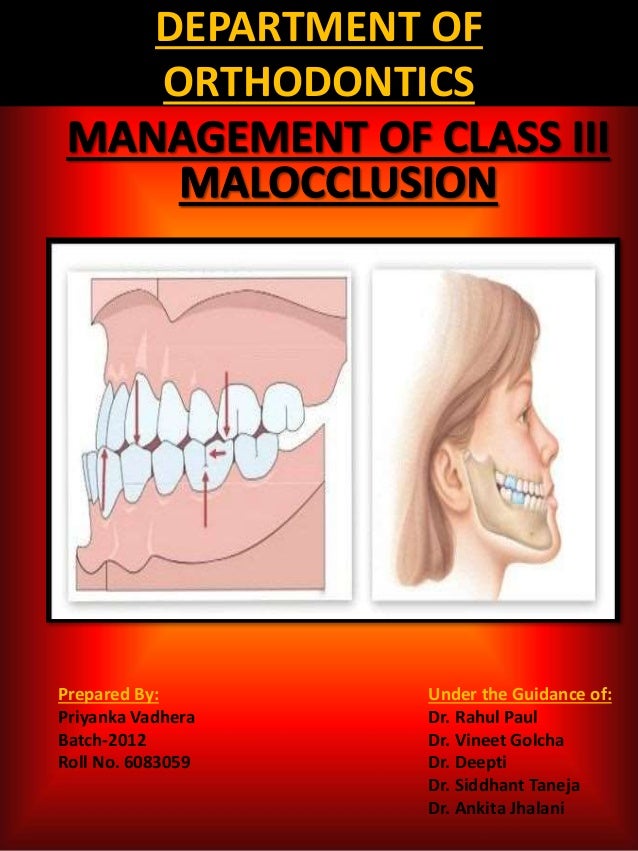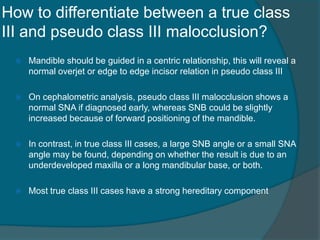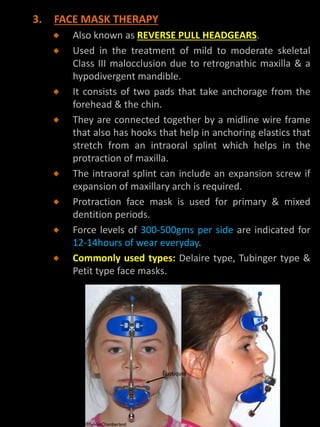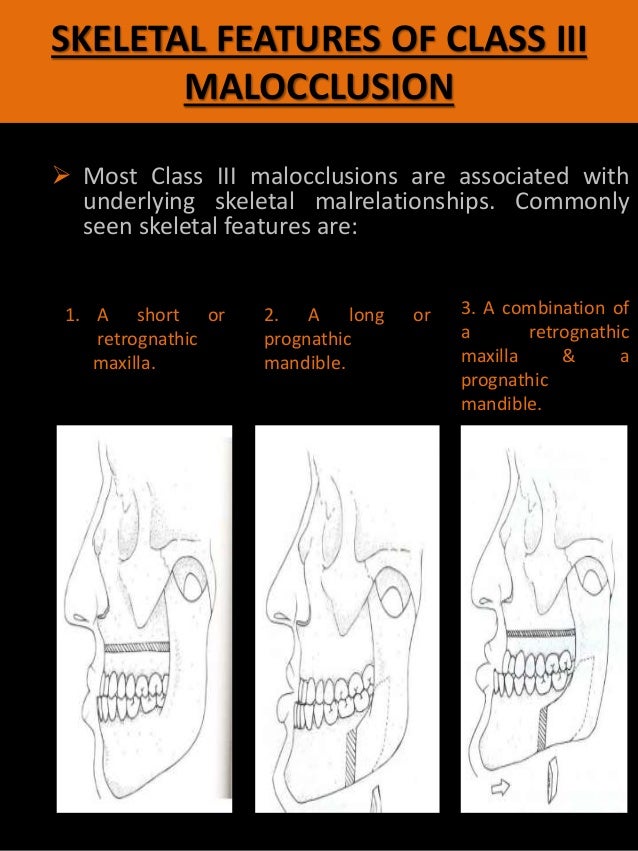class iii malocclusion slideshare
Prevalence of class III malocclusion in Caucasians ranges from 08 to 40 and rises up to 1213 in Chinese and Japanese populations while in North Indian population class III malocclusion is found in up to 34 of The upper teeth are more advanced compared to the lower teeth a 11-mm. For many class III malocclusions both surgical and orthodontic treatment are required.
A class III malocclusion can be of dental or skeletal origin so it is crucial to classify the malocclusion accurately in order to manage it on a sound clinical basis.
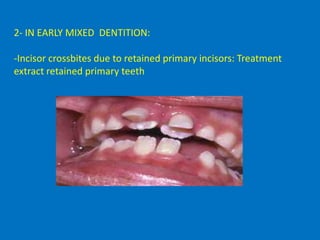
. Share yours for free. Angle described class III malocclusion as one in which the mandibular first molar is positioned mesially relative to the maxillary first molar Angle 1900. This type of malocclusion involves a number of cranial base and maxillary and mandibular skeletal and dental compensation components.
Lesmana 2003 states that these factors can lead. Very easy to identify but is often Difficult to treat. Pseudo Class III Malocclusion Pseudo class III malocclusion is a habitual established cross bite of all anterior teeth without any skeletal discrepancy resulting from functional forward positioningshift of the mandible on closure.
Female 18y Co- Gn1152mm BE. A class 3 malocclusion happens when the lower teeth protrude past the upper teeth. The overjet was increased in 953 Figure 10 and overbite in 767 Figure 11 of the patients with Class II division 1 malocclusion.
This is due to butterfly effect of expansion at the Midpalatal suture and because of the anterior sloping of the facial sutures. CLASS III MALOCCLUSION THE MESIOBUCCAL CUSP OF THE LOWER FIST MOLAR OCCLUDES MESIAL TO THE CLASS I POSITION. Class III Prognathism also known as underbite is a malocclusion caused by the lower teeth being positioned further forward than the upper teeth.
The overjet is reduced or reversed Ashraf 16 yrs old presented with incisor 3 relationship based on class 1 skeletal relationship with anterior crossbite and ectopic. A class 3 malocclusion can cause many issues because it makes it difficult for a person to bite properly and it can cause some self-esteem concerns. Learn new and interesting things.
PSEUDO CLASS III MALOCCLUSION Due to occlusal prematurity when the mandible moves from rest position to occlusion it slides forward into a pseudo class III position. Centric relation is the relationship of mandible to maxilla when the head of the condyle is in the most retruded unstrained position in the glenoid fossa. Population56 The prevalence is greater in Asian populations.
Class III malocclusion has a multifactorial etiology which is the. View Class 3 Malocclusion PPTs online safely and virus-free. Maxillomandibular relationships of Class III subjects progressively worsen between 6 and 16 years of age.
This is a pseudo-Class III malocclusion 5. 1- Sutural loosening 2- Correct transverse discrepancy that commonly associated with class III malocclusion 3- Displace the maxillary complex anteriorly. Our new CrystalGraphics Chart and Diagram Slides for PowerPoint is a collection of over 1000 impressively designed data-driven chart and editable diagram s guaranteed to impress any audience.
They are all artistically enhanced with visually stunning color shadow and lighting effects. The lower jaw pushes forward past the upper jaw sometimes so much so that the upper teeth rest inside the lower teeth. According to British Standards class iii incisor relationship includes those malocclusions where the lower incisor edge occludes anterior to the cingulum plateau of upper incisors.
Sometimes a Class III relationship is caused by a forward shift of the mandible to avoid incisal interferences. Malocclusion into 2 namely extrinsic and intrinsic. It is very difficult to diagnose and treat Class III malocclusion.
However it is important to specify that this patient shows an upper jaw upper maxilla displaced posteriorly or maxillary retrognathia. Class III malocclusion represents a growth-related dentofacial deformity with mandibular prognathism in relation to the maxilla andor cranial base. Abnormalities in tooth size shape and size premature loss prolonged retention and deciduous.
Depending on the amount of skeletal discrepancy surgical correction may consist of mandibular retraction maxillary protraction or a. Is 5 months longer in Class III vs Class I. Class iii malocclusion slideshare Monday May 16 2022 Edit.
Malnutrition bad habits and malfunctions posture and trauma. There are many other names for a class 3 malocclusion including an underbite or prognathism. Female 18y 8m Co- 1157mm Angle Orthod 201181211-6.
Class 3 malocclusion slideshare. The class III classification of medical devices follows rigorous controls most of which require a Premarket Approval PMA submission or De How to Classify a Class III Medical Device. Its also known as postural class III.
Class III malocclusion is considered to be one of the most difficult and complex orthodontic problems to treat. Overjet horizontal overlap of incisors. The plane of occlusion curve of spee should be flat to 15 mm deep.
As the name implies a patient with a malocclusion has teeth that do not properly connect with each other whenever a patient bites down. C- Rapid maxillary expansion ADVANTAGES. To malocclusion and even cause facial.
Class III malocclusion is a less frequently observed clinical problem than Class II or Class I malocclusion occurring in less than 5 of the US. This condition represents a pre-normalcy where the mandible is in a mesial relation to the upper arch According to Angle Class III molar relationship refers to a condition where the mesio-buccal cusp of the. Its prevalence varies greatly among and within different races ethnic groups and geographic regions studied.
Class III malocclusion A malocclusion that is. Typical Presentation OF Class 3 Malocclusion 6. The estimated incidence of Class III malocclusion among the Korean Japanese and Chinese is 4 to 14 because of the large percentage.
After surgical correction of the skeletal discrepancy the occlusion is usually finished orthodontically to a Class I relationship. Lemongello discusses all the steps taken to correct the malocclusion. A class III skeletal relationship can occur as a result of a normal maxilla with mandibular protrusion maxillary.
Get ideas for your own presentations. In Class III malocclusion originating from mandibular prognathism orthodontic treatment in growing patients is not a good choice and in most cases orthognathic. The lower incisors much more vertically.
Many of them are also animated. A pseudo class III malocclusion is caused by a forward shift of the mandible to avoid incisal interferences Proffit 1986. This cephalometric X-ray shows the anterior discrepancy of the lower jaw commonly called mandibular prognathism.
Class 3 malocclusion prognathism or underbite. Prevalence of class III malocclusion in Caucasians ranges from 08 to 40 and rises up to 1213 in Chinese and Japanese populations while in North Indian population class III malocclusion is found in up to 34 of the population. A malocclusion is an incorrect relationship between the maxilla upper arch and the mandible lower arch or a general misalignment of the teeth.
Centric occlusion maximum intercuspation of maxillary and mandibular teeth. Class III mandibular prognathism.

Class Iii Malocclusion Ppt Download

Management Of Class Ii And Iii Malocclusion

Treatment Of Class Iii Malocclusion Orthodontics
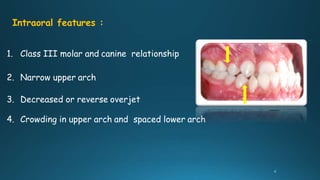
Treatment Of Class Iii Malocclusion
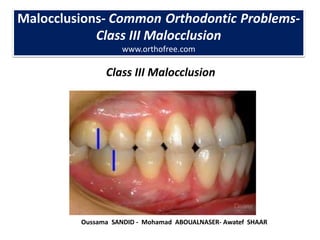
100 Malocclusions Common Orthodontic Problem Mohamad Aboualnaser Awat
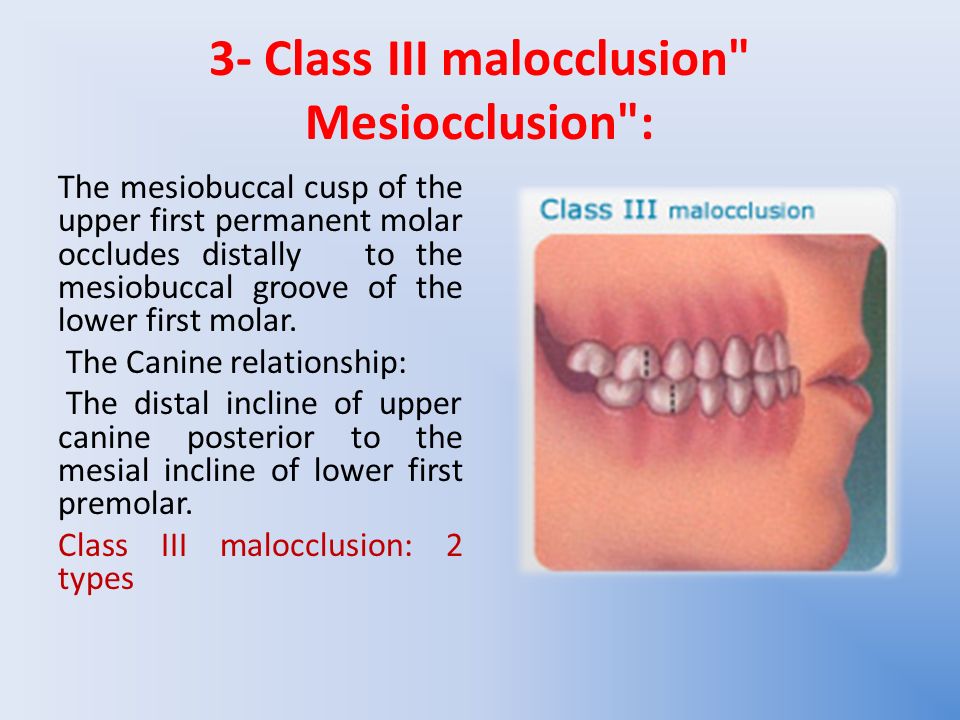
Orthodontic Dr Enas Talb 4th Class Ppt Video Online Download
